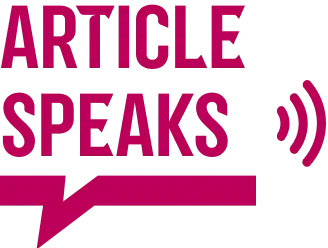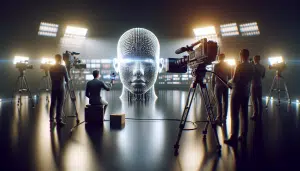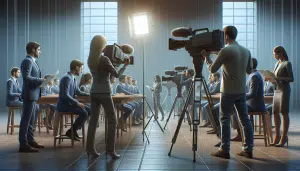Deepfake Detection Myths That Might Surprise You
Lily Carter October 31, 2025
Discover the unexpected realities behind deepfake detection and digital misinformation. This article uncovers the latest trends, tools, and ethical debates in the fight against fake news and explores the evolving challenges facing media, businesses, and individuals.
Why Deepfake News Is Spreading Fast
Modern news cycles change rapidly, yet the rise of ultra-realistic deepfakes has completely transformed the way information spreads. Deepfakes use artificial intelligence to seamlessly alter video, audio, or images, making fictional events seem authentic. As these creations circulate across social media and news platforms, distinguishing truth from fiction grows harder by the day. Digital misinformation has never been so convincing, affecting politics, business, and private lives with quick, viral impact. Even people who pride themselves on digital literacy may overlook deceptively real content.
Because deepfake content feels so authentic, it often slips past both automated detection tools and careful human review. These manipulated videos, voice clips, or images can influence public opinion within hours. Some analysts suggest that misinformation can erode trust in media institutions and even create confusion around election results. The amplified reach—courtesy of social feeds and messaging apps—serves to magnify concerns about legitimate news sources and fact-checking methods. It isn’t just celebrities or politicians at risk; personal reputations and private moments have been exploited as well.
Deepfakes often capitalize on lightning-fast dissemination. A trending hashtag or viral post can overpower slower, traditional verification methods in newsrooms. While platforms are working to apply more stringent checks, new deepfake iterations appear, sidestepping older filters. Audiences find themselves questioning headlines, worrying that even reputable news may be tainted by digital manipulation. These rapid changes fuel calls for improved deepfake detection and public education about misinformation risks.
Inside the Deepfake Detection Challenge
The art of deepfake detection has become a technological arms race. Artificial intelligence powers both the fakes and the countermeasures. Detection tools scan for digital inconsistencies—like unnatural blinking, pixel artifacts, or mismatched lighting—but deepfake creators often update their tactics to dodge these filters. As a result, no algorithm remains effective for long without continuous upgrades. The complexity of the challenge means detection is part science, part human intuition.
Even advanced researchers face hurdles. Some deepfakes are almost undetectable by standard algorithms, appearing flawless to both computers and casual viewers. These sophisticated fakes can slip into news reports, court evidence, or viral entertainment, fueling debates about media trust. Forensic experts rely on subtle cues—tiny shifts in facial muscle movement, strange audio resonances, or unnatural video compression artifacts—to catch the elusive few. New layers of verification, including blockchain-backed authenticity markers and device-based fingerprinting, are being piloted in response.
But the detection process isn’t infallible. Tools sometimes deliver false positives, tagging real content as fake, or failing to flag advanced deepfakes. This creates an uncertain environment for publishers, social networks, and the public. As deepfake creation tools become more accessible, education efforts are just as vital as technical advances. Awareness campaigns and public training are now emphasized as guards against digital misinformation’s evolving threats.
Who Is Most Affected by Digital Misinformation
Digital misinformation and synthetic media can affect almost anyone, but certain groups experience unique vulnerabilities. Public figures—such as politicians, actors, and business leaders—are frequent targets, with fakes designed to sway public opinion or damage reputations. These manipulated stories often gain traction simply due to the high-profile status of those involved. For organizations, a single deepfake news story can lead to costly investigations, erode customer confidence, and create long-lasting legal headaches. Sadly, even private individuals sometimes suffer when personal content is manipulated and widely shared without consent.
Minorities, activists, or minority political groups also face increased risks. Deepfake misinformation has been used to discredit protests, manipulate grassroots campaigns, or spread malicious rumors targeting vulnerable communities. Some research points to targeted misinformation campaigns as a strategy for undermining civic processes or creating division within social groups. Even small-scale deepfake incidents can have outsized impact in sensitive environments, leading to social backlash or even security risks.
In the workplace, digital misinformation can target entire organizations. Businesses may face fraudulent videos fueling rumors about product failures, corporate scandals, or data leaks. Such events test crisis communication preparedness and force leaders to address public doubts swiftly. Misinformation’s reach—and its possible harms—make robust media literacy an essential skill for everyone, regardless of professional background or public status. That’s a new reality for modern readers.
The Latest Tools in Deepfake Detection
In response to rising threats, several deepfake detection tools have been created by academic labs, tech corporations, and not-for-profit alliances. Open-source software like DeepFaceLab and commercial services such as Microsoft’s Video Authenticator analyze visual clues to spot inconsistencies. Social media companies are investing in in-house AI tools that automatically flag or suppress likely manipulations. This has led to partnerships with universities and government agencies to accelerate research and create accessible solutions. As the technology behind deepfakes and detection races forward, staying updated becomes critical for those combating misinformation.
Besides filtering imagery and sound, new systems are exploring authenticity labels and provenance trails. For example, digital watermarking techniques embed invisible tracers in genuine media, making future alterations detectable. Other platforms rely on cryptographic verification, offering tamper-evident logs about when and how content was created. These methods—while not foolproof—complement traditional post-distribution fact-checking, increasing the odds of tracing a fake before it causes harm.
Recently, the introduction of collaborative deepfake detection databases has strengthened efforts. By sharing known fake examples and detection metrics, researchers and organizations can update their systems faster. These pooled resources help deepfake defenses evolve in real-time, making it less likely that a single organization will fall behind emerging threats. Public education portals and online reporting tools empower users to flag suspicious content, further strengthening the ecosystem of digital trust.
Ethical and Legal Debates in the Deepfake Era
While technical approaches progress, deepfake news continues to raise ethical and legal questions. Should deepfake creation be outright banned or carefully regulated? Laws often lag behind innovations, creating gray zones in online harassment, identity theft, and misinformation. Some jurisdictions have criminalized malicious use, but defining intent and impact proves complex. Rights to free speech, privacy, and artistic expression intermix with urgent calls to protect the public from digital deception. This leads to domain-specific rules, differing by location and intended use.
Corporate ethics boards and newsroom guidelines are now clarifying their stance on handling synthetic media. Journalists, fact-checkers, and researchers are updating codes of conduct, emphasizing the need for visible corrections, transparency, and thorough verification. Ethical debates also extend to the responsibility of tech platforms—should social networks be more accountable for spreading fakes, or should user-driven flagging suffice? Collaborative protocols between governments, companies, and the public are in demand but remain a work in progress.
Legal experts are also assessing the limits of liability and damages from deepfake incidents. As legal cases begin to unfold, precedents will likely influence global policy for years. Meanwhile, public opinion is shaped by developing norms around image consent, source transparency, and personal digital security. Continued cross-border cooperation and regular reassessment of ethical guidelines will be essential to keeping the fight against digital misinformation just, effective, and fair.
Building Digital Literacy for a Deepfake World
With ever-improving technology, digital literacy stands out as a crucial defense against deepfake misinformation. Educational programs in schools and workplaces focus on critical thinking, helping people ask the right questions about sources, context, and authenticity. Learning to analyze visual and linguistic cues can help spot suspicious content before it spreads. Training to use fact-checking websites, browser extensions, and reporting functions fosters a habit of skepticism. No detection tool, however advanced, can replace the value of an informed and vigilant public.
Government and nonprofit organizations now offer open educational resources addressing deepfake threats. Interactive tutorials, classroom lesson plans, and online seminars have emerged to empower learners at every level. Topics include identifying digital manipulation, protecting personal information, and understanding the wider implications of synthetic media on society. As technology seeps into daily routines, a culture of ongoing education helps individuals and communities adapt to new risks.
The most effective strategies combine personal skill-building with collective action. Community groups and professional associations are developing mutual support networks for reporting suspicious news and sharing tips about emerging trends. Building this kind of resilience is ongoing work. Trustworthy media organizations, transparent digital tools, and responsible use of technology form a foundation for navigating the uncertain future of online information. The deepfake era is here—adapting is not optional.
References
1. Paris, B. (2021). Deepfakes and the New Disinformation War. Retrieved from https://www.cfr.org/report/deepfakes-and-new-disinformation-war
2. Chesney, R., & Citron, D. K. (2019). Deep Fakes: A Looming Challenge for Privacy, Democracy, and National Security. Retrieved from https://harvardlawreview.org/2019/02/deep-fakes-a-looming-challenge-for-privacy-democracy-and-national-security/
3. Mirsky, Y., & Lee, W. (2021). The Creation and Detection of Deepfakes: A Survey. Retrieved from https://cacm.acm.org/magazines/2021/1/249449-the-creation-and-detection-of-deepfakes/fulltext
4. U.S. Department of Homeland Security. (2021). Combating Deepfake Threats. Retrieved from https://www.dhs.gov/science-and-technology/news/2021/09/14/feature-article-combating-deepfake-threats
5. BBC News. (2020). Deepfake Technology: How and Why It Works. Retrieved from https://www.bbc.com/news/technology-51249867
6. UNESCO. (2022). Balancing freedom of expression and the threat posed by deepfakes. Retrieved from https://en.unesco.org/news/balancing-freedom-expression-and-threat-posed-deepfakes







